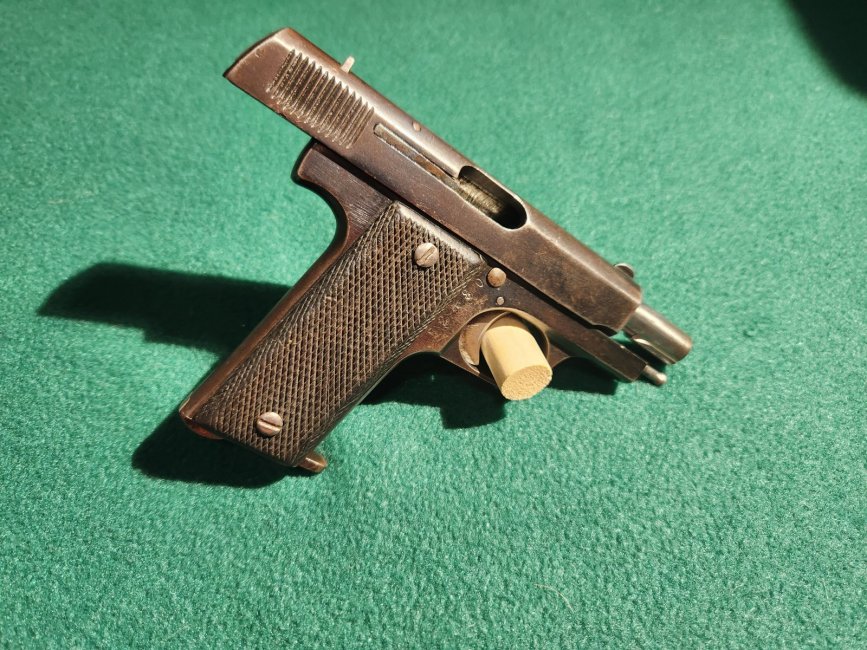There was a small firearms auction over in Smithsburg last month and while I was browsing through the catalog, I had two pistols catch my eye. The first was a German Occupation CZ27, and the other was this French Contract Ruby made by Garate, Anitua y Cia of Eibar Spain. There were a few other attention-getters in the catalog that were further down the list, so I figured I stood a chance of grabbing at least one of these for a reasonable price as bidders held onto their dollars to try and win some more expensive guns that were hammering later than these. I checked the completed GB listings for both the Ruby and the CZ and then carefully figured out my max for each. When the timer ran out, I was the high bidder on both and still below my conservative max bid on each.
First up is the Ruby:
- All Ruby pistols made for the French Military Contracts typically have a one or two-letter manufacturer's code in an oval above and to the rear of the left grip. This was supposed to ensure that the French Military was getting pistols from vetted workshops that had some form of quality control. The letters on this pistol are very faint from wear, but the only known company to have an 'N' as the second letter was Garate Anitua y Cia of Eibar. Their two-letter code was GN, and under a strong light, you can make out the lower half of the 'G' on this pistol.
- Once each pistol was inspected by the French Military and accepted into service, it was to receive two star-shaped stamps, one on either side of the mag well. This didn't always happen depending on the severity of need at the front, but more often than not, pistols were properly checked and then marked, sometimes only one star was stamped to save time. This particular example has stars extant on both sides of the mag well which is correct. This means that the pistol was accepted and issued by the French Military during WWI
- Eventually, many Ruby pistols had a rivet added to the slide above the safety lever. This was to help prevent the safety from being accidentally disengaged as the pistol was drawn from overly tight French military holsters. The idea was that the rivet would create space between the holster and the knurled surface of the safety to prevent it from catching on the leather. Again, time was of the essence for the French, and the rivets were added post-manufacture, so not all Ruby pistols have this feature, including this example.
- Over a million Ruby Pistols were manufactured by more than 45 different workshops in Eibar. Not only did they supply the French, but also the Italians who were also struggling to keep up with domestic production.
- The barrel in this particular example is extremely worn. There's rifling, but not much. I sincerely doubt that it was worn down by the war so much as someone firing it quite a bit in peacetime. Add in the fact that the quality control on these pistols was often lackluster (though the French military contract pistols are generally much better than the commercial versions) the rifling likely wasn't extremely deep or defined to start with.
- Other than the barrel, the rest of the pistol is in rather great shape for what is likely a 105+ years old military relic. I was extremely surprised that the grips are still in good shape overall with no cracking or dry rot.
- While it might not be super accurate, and will probably sit in the safe, the price was extremely reasonable and it's worth more than I have in it, so I'm happy overall.

Here you can see the faint oval at the rear of the left side of the frame. The letter code is GN for Garate, Anitua y Cia of Eibar Spain

This is a simple blow-back pistol in .32ACP. There is no bolt-hold-open, but the takedown notch and safety can be used to hold the slide to the rear for disassembly


Here is a closer shot of the very worn (GN) mark denoting the manufactures as Garate, Anitua y Cia of Eibar

While post-war commercial models would also sport a lanyard loop, they were of a fixed nature with the ends of the loop attaching directly to the frame.
Here you can also see the two star-shaped stamps denoting French Military acceptance and issuance.
These marks, combined with the single or double-letter oval marking are the only way to know if a particular arm was a military contract gun for the French Army.

The Ruby's magazine held 9 rounds of .32ACP in a single stack. This was substantially more than most other pistols of the time.


First up is the Ruby:
- All Ruby pistols made for the French Military Contracts typically have a one or two-letter manufacturer's code in an oval above and to the rear of the left grip. This was supposed to ensure that the French Military was getting pistols from vetted workshops that had some form of quality control. The letters on this pistol are very faint from wear, but the only known company to have an 'N' as the second letter was Garate Anitua y Cia of Eibar. Their two-letter code was GN, and under a strong light, you can make out the lower half of the 'G' on this pistol.
- Once each pistol was inspected by the French Military and accepted into service, it was to receive two star-shaped stamps, one on either side of the mag well. This didn't always happen depending on the severity of need at the front, but more often than not, pistols were properly checked and then marked, sometimes only one star was stamped to save time. This particular example has stars extant on both sides of the mag well which is correct. This means that the pistol was accepted and issued by the French Military during WWI
- Eventually, many Ruby pistols had a rivet added to the slide above the safety lever. This was to help prevent the safety from being accidentally disengaged as the pistol was drawn from overly tight French military holsters. The idea was that the rivet would create space between the holster and the knurled surface of the safety to prevent it from catching on the leather. Again, time was of the essence for the French, and the rivets were added post-manufacture, so not all Ruby pistols have this feature, including this example.
- Over a million Ruby Pistols were manufactured by more than 45 different workshops in Eibar. Not only did they supply the French, but also the Italians who were also struggling to keep up with domestic production.
- The barrel in this particular example is extremely worn. There's rifling, but not much. I sincerely doubt that it was worn down by the war so much as someone firing it quite a bit in peacetime. Add in the fact that the quality control on these pistols was often lackluster (though the French military contract pistols are generally much better than the commercial versions) the rifling likely wasn't extremely deep or defined to start with.
- Other than the barrel, the rest of the pistol is in rather great shape for what is likely a 105+ years old military relic. I was extremely surprised that the grips are still in good shape overall with no cracking or dry rot.
- While it might not be super accurate, and will probably sit in the safe, the price was extremely reasonable and it's worth more than I have in it, so I'm happy overall.

Here you can see the faint oval at the rear of the left side of the frame. The letter code is GN for Garate, Anitua y Cia of Eibar Spain

This is a simple blow-back pistol in .32ACP. There is no bolt-hold-open, but the takedown notch and safety can be used to hold the slide to the rear for disassembly


Here is a closer shot of the very worn (GN) mark denoting the manufactures as Garate, Anitua y Cia of Eibar

While post-war commercial models would also sport a lanyard loop, they were of a fixed nature with the ends of the loop attaching directly to the frame.
Here you can also see the two star-shaped stamps denoting French Military acceptance and issuance.
These marks, combined with the single or double-letter oval marking are the only way to know if a particular arm was a military contract gun for the French Army.

The Ruby's magazine held 9 rounds of .32ACP in a single stack. This was substantially more than most other pistols of the time.



